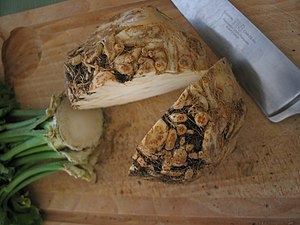Celery Root or Celeriac has got to be one of the ugliest vegetables out there. Its bumpy, with lots of crevices for dirt to hide in. While celeriac is a root vegetable, it is not the actual root of the celery we eat today. Instead it is derived from a species of wild celery and has been eaten for a long time. It’s mostly popular in Europe and Western Asia. But, with its nutty flavor with hints of celery and parsley, it should be used here more regularly. It can be eaten either raw or cooked.
At this time of year, any vegetable which can be used in salads is a winner. Raw celeriac helps satisfy that crunchy vegetable requirement which makes it great for winter salads. Cooked, it can substitute for potatoes in many recipes for a lower carbohydrate count or be used in soups, stews and purees. Its versatile enough to stand up to being mashed, boiled, sautéed, braised or baked.
Nutritionally, celeriac is not a power-house vegetable. It’s not super high in most vitamins or minerals, but it’s still a good food to use. As a substitute for potatoes, raw celeriac will only cost you 12 carbohydrates in a cup versus 23 for a cup of potatoes. It gives you small amounts of calcium, potassium and is low in sodium.
When buying celeriac, look for firm ones that don’t have any spongy spots or discolorations. Smaller is better in this case, larger ones tend to taste woody and are better for roasting or long stewing. Most suggestions for storing are in the refrigerator in a brown paper bag for up to a week, but I’ve been able to store them longer. Because celeriac is so lumpy, it needs to be cleaned and peeled carefully. Make sure that all bits of skin are removed (you will have to remove some of the actual flesh to achieve this. 1 pound of celeriac will probably give you about 2 cups of product because of this.
As with all root vegetables, you want to try to find organic celeriac. Because we eat the root of this plant, it tends to absorb whatever is in the dirt surrounding it. When preparing it, make sure to drop the cut pieces of celeriac into water which has either lemon or lime juice or citric acid in it to prevent it from browning.
Recipes
Soups
- Creamy Curried Celery Root Soup (Mark Bittman) – New York Times
- Celery Root Soup with Brussels Sprouts and Chestnuts – Martha Stewart
- Seafood in Celery Root and Lovage Broth – Epicurious
- Celery Root and Ginger Gold Apple Soup – Martha Stewart
Salads
- Celery Root and Beet Salad – Epicurious
- Celery Root Remoulade – David Lebovitz
- Celery Root and Apple Slaw – Martha Stewart
Side Dishes
- Celery Root and Potato Mash with Horseradish – Food Network
- Mashed Potatoes and Celeriac with Wild Mushrooms – Martha Stewart
- Rosemary Roasted Celery Root – Everyday Health
Main Dishes
- Braised Chicken with Celery Root and Garlic – Epicurious
- Potato and Celery Root Rosti – Martha Stewart
- Fennel and Celery Root Casserole – All Recipes
Related articles
- What can I do with Celeriac? (gfgh.wordpress.com)
- A celeriac a day… (modernworkinggirl.com)


I’ve used it all sorts of ways, but my favorite is the thing I had first: a sort of potato-salad concoction, but with celeriac boiled tender and cut up. Olive oil, vinegar, salt, pepper. Served cold, as a picnic food. Delightful.
I’ll have to try that. I’ve used it soups and stews as a low carb potato substitute, puréed and shredded in salads.